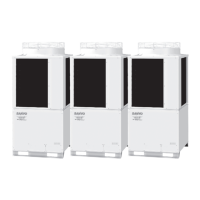2-8
Design of W-2WAY ECO-i SYSTEM Unit Specifications
1
2
3
4
5
6
7
8
Straight equivalent length of joints
1-5. Straight Equivalent Length of Joints
Design the tubing system by referring to the following table for the straight equivalent length of joints.
Straight Equivalent Length of Joints
Wide tubing size (mm) 12.7 15.88 19.05 22.22 25.4 28.58 31.8 38.1
90° elbow 0.3 0.35 0.42 0.48 0.52 0.57 0.7 0.79
45° elbow
0.23 0.26 0.32 0.36 0.39 0.43 0.53 0.59
U-shape tube bent (R60 - 100 mm)
0.9 1.05 1.26 1.44 1.56 1.71 2.1 2.37
Trap bend 2.3 2.8 3.2 3.8 4.3 4.7 5.0 5.8
Y-branch distribution joint
Equivalent length conversion not needed.
Ball valve for service Equivalent length conversion not needed.
Capacity loss caused by differences in tubing diameters
* Capacity loss will occur if a tubing system that matches the horsepower is not selected (for example, if a tubing system was
determined and installed with no plan for extension and extension occurs later). The loss rate can be found from the graph
below.
Cooling
Heating
95
96
97
98
99
100
Capacity ratio based on Gas
tube diameter (%)
Recommended Gas tubes diameter (mm)
ø19.05 ø22.22
ø22.22
ø28.58
ø28.58
ø31.75
ø31.75 ø38.1
ø25.4
ø25.4
10 12 14 16 18 20 26 30 35 40 45 46 47 48
(Reading the graph)
<Example 1>
Currently a 20 HP system and 28.58 Gas tubing are used. Subsequently the system is expanded, with 8 HP added to the
same tubing system.
Horsepower after extension: 20 + 8 = 28 HP
From the graph above: Cooling: Capacity ratio is 96.7%. Actual capacity = 28 × 0.967 = 27.1 HP
Heating: Capacity ratio is 98.6%. Actual capacity = 28 × 0.986 = 27.6 HP
1. Model Selecting and Capacity Calculator

